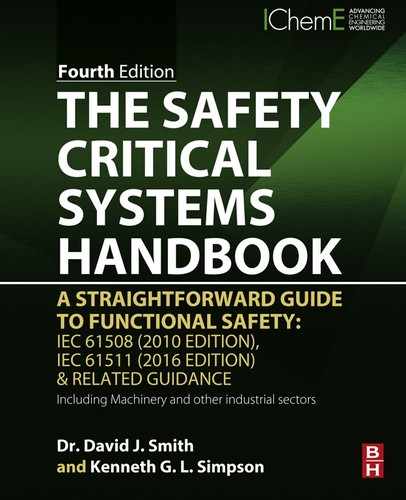Appendix 4
Assessing Safe Failure Fraction and Diagnostic Coverage
In Chapter 3 Safe Failure Fraction (SFF) and random hardware failures were addressed and reference was made to FMEA.
1. Failure Mode and Effect Analysis
Figure A4.1 shows an extract from a failure mode effect analysis (FMEA) covering a single failure mode (e.g., OUTPUT FAILS LOW).
Columns (A) and (B) identify each component.
Column (C) is the total part failure rate of the component.
Column (D) gives the failure mode of the component leading to the failure mode (e.g., FAIL LOW condition).
Column (E) expresses Column (D) as a percentage (e.g., 20% for U8).
Column (F) multiplies Column (C) by (D) to produce the hazardous failure rate.
Column (H) multiplies the mode failure rate by the diagnostic coverage for each component and calculates the revealed hazardous failures.
Column (I) describes the “safe” failure state.
Column (J) expresses Column (I) as a percentage (e.g., 60% for R6).
Column (K) multiplies Column (J) by (C) to produce the safe failure rate.
Cells at the bottom of the spreadsheet in Figure A4.1 contain the algorithms to calculate diagnostic coverage (64%) and SFF (84%).
Average Diagnostic coverage is obtained from the sum of column H divided by the sum of column F.
Typically this type of analysis requires four man days of effort based on a day's meeting for a circuit engineer, a software engineer who understands the diagnostics, and the safety assessor carrying out the “component-by-component” review. A further day allows the safety assessor to add failure rates and prepare the calculations and a report.
2. Rigor of the Approach
In order demonstrate the rigor of the FMEA exercise, Table A4.1 provides a template of items to be addressed. It can thus be used, in the FMEA report, to indicate where each item can be evidenced.
Table A4.1
| A definition of the equipment's intended safety function and perceived failure mode | Section? of this |
| Summary of failure data used | Section? of this |
| General and specific assumptions | Section? of this |
| Spreadsheet (or FARADIP output) showing, for each failure mode of the equipment, the component failure rates, and modes (for each block identified in the reliability/fault model) the data source used (with any justifications if necessary) | Section? of this |
| Where the FMEA involves more than one function block, then there needs to be a reliability block diagram (or fault tree), including common cause failure, to show the interrelationship of blocks. Calculations (including the MTTR, proof test intervals, failure rates, etc.) should be shown. | Section? of this |
| Justification for any diagnostic coverage claimed for each component (if over 60%). This may involve a separate textual section describing the hardware/software/watchdog arrangements | Section? of this |
| Where applicable, the predicted effect of temperature variation on the failure data used, (e.g. elevated temperature approaching the maximum junction temperature) | Section? of this |
| Where applicable, the failure rate data are factored, where components (such as power transistors, electrolytic capacitors) have been used above 70% of their rated load | Section? of this |
| Where applicable, the failure rate data are factored, to allow for the effect of high vibration | Section? of this |
| Identification of any life limited components, together with maintenance/replacement requirements (e.g., batteries, electrolytic capacitors, electromechanical components, etc.) | Section? of this |
| Documented evidence of a theoretical circuit design review (showing scope, findings, reviewer independence, etc.) | Section? of this |
Circuit design information: Schematics, including block diagram if multiboard Parts list Functional description including onboard diagnostics (if any) | Section? of this |
| Safety requirements specification and/or brief product specification (e.g., datasheet) including environmental and application information | Section? of this |
..................Content has been hidden....................
You can't read the all page of ebook, please click here login for view all page.

